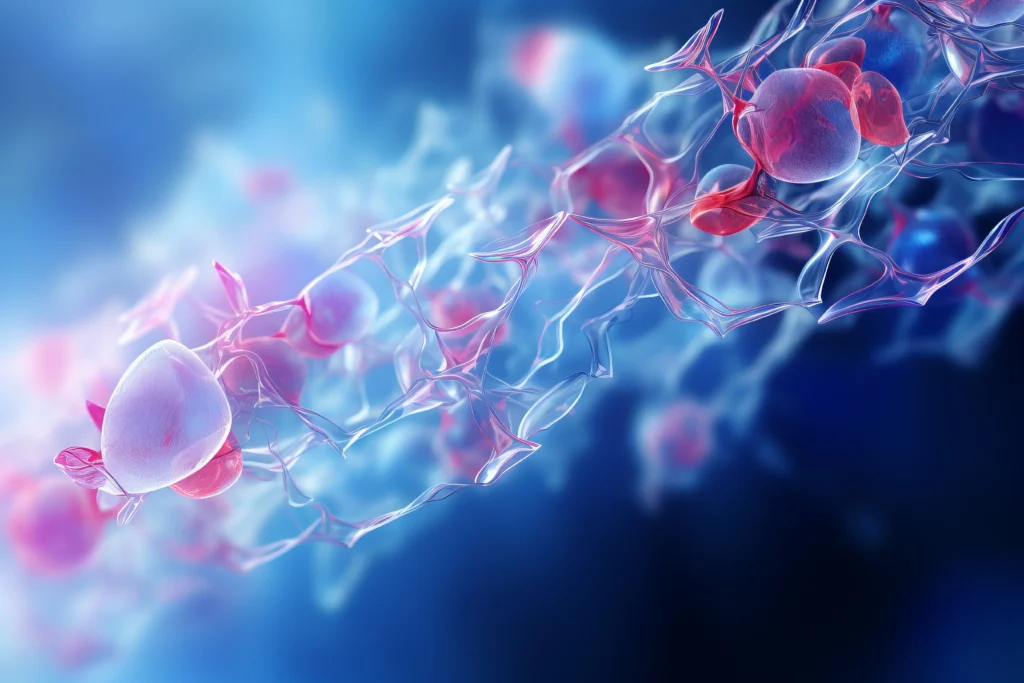A torn hip labrum isn’t just a cartilage injury — it’s a disruption of the joint’s seal, stability, and mechanics. At SIGMA Orthopedics, we combine high-resolution imaging, dynamic movement testing, and advanced arthroscopic expertise to identify the exact pattern of your labral tear and build a tailored plan for healing, preservation, and long-term hip protection.

This comprehensive, surgeon-led assessment tells us whether your hip needs targeted physical therapy, orthobiologics, image-guided injections, arthroscopic labral repair, reconstruction, or a combined preservation strategy.
Your anatomy, goals, and functional demands define the path — not a one-size-fits-all template.
At SIGMA, our goal is simple: find the exact source of your pain, fix it with precision, and guide you through a data-driven return to full activity.

The labrum is a ring of cartilage that lines the edge of the hip socket. It acts like a gasket—deepening the socket, stabilizing the ball of the femur, and helping the joint move smoothly.
A hip labral tear happens when this cartilage frays or pulls away from the bone.
This can be caused by:
Structural issues such as femoroacetabular impingement (FAI)
Repetitive loading in sports like soccer, hockey, dance, and running
Traumatic events such as falls, car accidents, or sudden twists
Degenerative changes over time

Corrects mechanics and improves hip stability, core, and glute function.
Corticosteroid injections for short-term pain relief in select cases.
PRP, A2M, and other biologics to help modulate inflammation and support healing in carefully selected patients.
Detailed movement exam: assessing hip rotation, impingement signs, and functional strength.
Targeted imaging: high-quality X-rays to evaluate bone shape (FAI), plus MRI or MR arthrogram when needed to visualize the labrum and cartilage.
Dynamic ultrasound when appropriate: to evaluate associated tendon or psoas involvement.
Diagnostic injections: image-guided anesthetic injections to confirm that the pain is coming from inside the joint.
This step-by-step process ensures we are treating the true source of your symptoms—not just the MRI.


to reduce complications and improve consistency
when appropriate
Hip labral tears are significant injuries affecting the labrum, a specialized cartilage ring that follows the outside rim of the hip joint socket. The labrum acts as a rubber seal or gasket to help hold the femoral head securely within the acetabulum, providing joint stability and ensuring smooth movement.
These injuries commonly occur in athletes participating in sports requiring repetitive hip rotation or pivoting movements, such as football, soccer, hockey, and dance. However, they can also result from structural abnormalities like femoroacetabular impingement (FAI), trauma, or degenerative conditions.
Common symptoms include anterior hip or groin pain, clicking or locking sensations, stiffness, and decreased range of motion. Pain typically worsens with activity, particularly with hip flexion and rotation. Patients may experience difficulty with prolonged sitting, climbing stairs, or getting in and out of vehicles.
Diagnosis begins with a comprehensive physical examination, including specific provocative tests like the FADIR (flexion, adduction, internal rotation) test and FABER (flexion, abduction, external rotation) test. While plain radiographs are useful for identifying underlying structural abnormalities, magnetic resonance arthrography (MRA) remains the gold standard for definitively diagnosing labral tears.
Conservative management typically includes activity modification, physical therapy focusing on hip strengthening and stability, and non-steroidal anti-inflammatory medications. Physical therapy protocols emphasize core strengthening, hip mobility, and biomechanical correction to address underlying movement patterns that may have contributed to the injury.
When conservative treatment fails, arthroscopic surgery may be indicated. The procedure involves repairing or debriding the torn labrum and addressing any underlying structural abnormalities. Success rates for arthroscopic treatment are generally favorable, with studies showing significant improvement in pain and function in 85-90% of appropriately selected patients.
Post-operative rehabilitation is crucial for optimal outcomes. The typical protocol involves a period of protected weight-bearing, followed by progressive strengthening and range of motion exercises. Return to sport usually occurs between 4-6 months post-surgery, depending on the individual’s progress and sport-specific demands.
Prevention strategies include proper warm-up, maintaining hip flexibility and strength, and addressing biomechanical issues that may predispose to labral injury. Athletes in high-risk sports should focus on proper technique and avoid excessive training loads that may increase injury risk.
Long-term outcomes following appropriate treatment are generally favorable, though some patients may experience persistent symptoms or develop early osteoarthritis. Regular monitoring and maintenance exercises are recommended to prevent recurrence and maintain optimal hip function.
Recent advances in surgical techniques and rehabilitation protocols continue to improve outcomes for patients with labral tears, making early recognition and appropriate management crucial for optimal results.
Hip labral tears are a common injury in athletes, particularly those involved in sports requiring repetitive hip flexion and rotation. This report provides an overview of hip labral tears from a sports medicine perspective, focusing on anatomy, etiology, diagnosis, and management.
Anatomy:
The acetabular labrum is a fibrocartilaginous ring that surrounds the acetabulum, deepening the hip socket and providing stability to the hip joint. It plays crucial roles in:
• Maintaining joint lubrication
• Distributing pressure across the joint
• Enhancing joint proprioception • Providing a suction seal for joint stability
Etiology:
Hip labral tears can result from:
1. Traumatic injuries:
• Sudden twisting or pivoting motions
• Falls or direct impacts to the hip
2. Repetitive microtrauma:
• Common in sports like soccer, hockey, and dance
3. Femoroacetabular impingement (FAI):
• Cam-type: Bony overgrowth on femoral head/neck
• Pincer-type: Overcoverage of acetabulum
• Mixed-type: Combination of cam and pincer
4. Developmental hip disorders:
• Hip dysplasia
• Legg-Calve-Perthes disease
5. Degenerative changes:
• Age-related wear and tear
Risk Factors:
• Participation in high-impact or rotational sports
• Anatomical variations (e.g., FAI, hip dysplasia)
• Gender (more common in females)
• Age (peak incidence in young adults and middle-aged individuals)
• Previous hip injuries or surgeries
Clinical Presentation:
Patients with hip labral tears may present with:
• Anterior hip or groin pain
• Clicking, locking, or catching sensations
• Pain exacerbated by hip flexion, internal rotation, or prolonged sitting
• Decreased range of motion
• Hip instability or giving way
• Pain with weight-bearing activities
Diagnosis:
1. History and Physical Examination:
• Detailed sports and activity history
• Assessment of pain patterns and mechanical symptoms
• Special tests:
– FADIR (Flexion, Adduction, Internal Rotation) test
– FABER (Flexion, Abduction, External Rotation) test
– Resisted straight leg raise
– Log roll test
2. Imaging Studies:
• X-rays:
– To assess bony anatomy and rule out other pathologies
– AP pelvis, frog-leg lateral, and false profile views
• MRI:
– Gold standard for labral tear diagnosis
– Preferably with arthrogram (MRA) for enhanced sensitivity • CT scan:
– Useful for assessing bony morphology in cases of FAI
3. Diagnostic Injections:
• Intra-articular anesthetic injection for diagnostic confirmation
Management:
Treatment of hip labral tears depends on the severity of symptoms, patient age, activity level, and associated pathologies.
1. Conservative Management:
• Activity modification and rest • Physical therapy:
– Core strengthening
– Hip stabilization exercises
– Range of motion exercises
– Gait training
• NSAIDs for pain and inflammation
• Intra-articular corticosteroid injections for short-term relief
2. Surgical Management: Indications:
• Failure of conservative treatment
• Significant functional limitations
• High-level athletes aiming to return to sport
Techniques: a) Hip Arthroscopy:
• Minimally invasive approach
• Labral repair or debridement
• Treatment of associated pathologies (e.g., FAI correction)
• Advantages:
– Faster recovery
– Lower complication rates
– Better visualization of intra-articular structures
b) Open Surgery:
• Reserved for complex cases or revision surgeries
• Surgical hip dislocation for comprehensive access
Procedures:
• Labral repair: Preferred when tissue quality permits
• Labral debridement: For irreparable tears
• Labral reconstruction: Using autograft or allograft tissue
• Concomitant procedures:
– Femoral osteochondroplasty for cam-type FAI
– Acetabular rim trimming for pincer-type FAI
– Microfracture for chondral defects
Rehabilitation:
Post-operative rehabilitation is crucial for optimal outcomes: Phase 1 (0-4 weeks):
• Protection of repaired tissues
• Passive range of motion exercises
• Isometric strengthening
• Gait training with crutches
Phase 2 (4-8 weeks):
• Progressive weight-bearing
• Active range of motion exercises
• Initiation of core and hip strengthening
Phase 3 (8-12 weeks):
• Full weight-bearing
• Advanced strengthening exercises
• Proprioception training
• Low-impact cardiovascular exercises
Phase 4 (12+ weeks):
• Sport-specific training
• Plyometrics and agility drills
• Gradual return to sport activities
Return to Sport:
• Typically 4-6 months post-surgery
• Criteria-based progression:
– Full, pain-free range of motion
– Restored strength (>90% of contralateral side)
– Successful completion of sport-specific functional tests
Outcomes:
• Success rates of 80-90% reported in literature
• Factors influencing outcomes:
– Preoperative duration of symptoms
– Extent of cartilage damage
– Presence of FAI or dysplasia
– Adherence to rehabilitation protocol
Complications:
• Rare but potential complications include:
– Infection
– Deep vein thrombosis
– Heterotopic ossification
– Iatrogenic chondral or labral injury
– Femoral neck fracture (in cases of aggressive cam resection)
Prevention Strategies:
• Proper warm-up and cool-down routines
• Core and hip strengthening programs
• Technique modification in high-risk sports
• Early identification and management of FAI
Future Directions:
• Improved understanding of labral biomechanics
• Advanced imaging techniques for early diagnosis
• Biological augmentation (e.g., growth factors, stem cells)
• Refinement of arthroscopic techniques and instruments